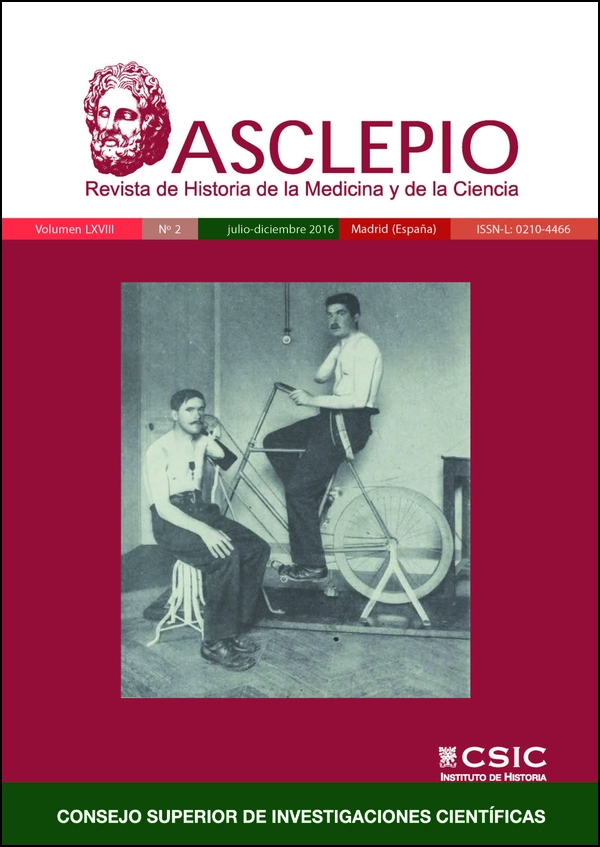“Shameful diseases” and the legal regulation of prostitution. Rosario-Argentina (1874-1932)
DOI:
https://doi.org/10.3989/asclepio.2016.28Keywords:
Prostitution, Regulation, Venereal diseases, Rosario, Representations, 1874-1932Abstract
In late 19th and early 20th century venereal diseases received special attention in the medical, journalistic and political speeches. Local regulations regarding the issue of prostitution and the tipical problems of cities which, like Rosario, underwent a process of sudden modernization, accounted for this special attention. Prostitution appeared in epochal representations associated with venereal diseases, especially syphilis and gonorrhea, witch, together with alcoholism and tuberculosis, were characterized as some of the major preventable social ills. Prostitution was perceived as the main source of sexually transmitted infections. In this work we analyze discourses on venereal diseases also called “secret” at that time; we also analyse the fears these instilled in society and the prophylactic practices adopted to protect the individual bodies and the social body of the city when the regulated prostitution system was in force in Rosario (1874-1932).
Downloads
References
Armus, Diego (2000), “El descubrimiento de la enfermedad como problema social”. En: Lobato, Mirta (dir.), Nueva Historia Argentina, T. 5, Bs As, Sudamericana, pp. 507-551.
Corbin, Alain (2005), “El encuentro de los cuerpos”. En: Corbin, A (dir.), Historia del cuerpo, V. 2, Madrid, Taurus, pp. 141-201.
Corbin, Alain (1991), “L’hérédosyphilis ou l’impossible rédemption. Contribution à l’histoire de l’hérédité morbide”. En Corbin, A., Le Temps, le Désir et l’Horreur. Essair sur le dix-neuvième siècle, París, Ed. Aubier, pp. 141-169.
Costler, A. y Willy, A. (1954), Enciclopedia del conocimiento sexual, Bs As, Ed. Claridad.
Costa, Enzo Fernando (1977), Historia de la sífilis y de los hombres que lucharon contra ella, Bs As, EUDEBA.
Fernández Verano, Alfredo (1935), Por la salud y el vigor de la raza. Plan de defensa social contra las enfermedades venéreas, Bs As, Liga Argentina de Profilaxis Social.
Foucault, Michel (1985), Historia de la sexualidad. Tomo I: La voluntad de saber, México, Siglo XXI.
Fournier, Alfred (s/f), La sífilis y demás enfermedades venéreas. Sus orígenes y medios para combatirla, Buenos Aires, Claridad.
Gay, Peter (1992), La experiencia burguesa. Tomo II: Tiernas pasiones, México, FCE.
Greco, Nicolás (1922), ¿Tengo yo sífilis?, Buenos Aires, El Ateneo.
Guy, Donna, (1994), El sexo peligroso. La prostitución legal en Buenos Aires. 1875-1955, Buenos Aires, Sudamericana.
Kuhn, Thomas S. (2013), La estructura de las revoluciones científicas, México, FCE.
Múgica, María Luisa (2004), “Los contratiempos del amor venal. La prostitución vista como foco de insalubridad: miradas abolicionistas rosarinas hacia 1932”. En: Álvarez, A., Molinari, I. y Reynoso, D. (ed.) Historias de enfermedades, salud y medicina en la Argentina de los siglos XIX-XX, Mar del Plata, UNMDP, pp. 209-233.
Múgica, María Luisa (2014), La ciudad de las Venus impúdicas. Rosario, historia y prostitución (1874-1932), Rosario, Laborde.
Muniagurria, Camilo (s/f), Como se evita y cómo se cura la sífilis, Rosario, La Casa del libro.
Muniagurria, Camilo (1922), Como se evita y cómo se cura la sífilis, Buenos Aires, Moro, Tello y Cía (con fotografías).
Omnés, Charles (1904), Concepto moderno de higiene (Necesidad de su enseñanza), Rosario, Wetzel y Buscaglione.
Peset, José Luis (1983), Ciencia y marginación. Sobre negros, locos y criminales, Madrid, Crítica-Grijalbo.
Pignetto, Manuel (1901), Consideraciones generales sobre la profilaxia de la sífilis, Tesis para el doctorado en Medicina, Buenos Aires, UBA.
Pignetto, Manuel (1922), Profilaxis pública de la avariosis en la República Argentina, Rosario, Di Pierri Hnos.
Sontag, Susan (2012), El sida y sus metáforas, Buenos Aires, DeBolsillo.
Trochon, Yvette (2003), Las mercenarias del amor. Prostitución y modernidad en el Uruguay (1880-1932), Montevideo, Taurus.
Walkowitz, Judith (1996), Prostitution and Victorian Society. Women, class, and the state, Cambridge, Cambridge University Press.
Published
How to Cite
Issue
Section
License
Copyright (c) 2016 Consejo Superior de Investigaciones Científicas (CSIC)

This work is licensed under a Creative Commons Attribution 4.0 International License.
© CSIC. Manuscripts published in both the print and online versions of this journal are the property of the Consejo Superior de Investigaciones Científicas, and quoting this source is a requirement for any partial or full reproduction.
All contents of this electronic edition, except where otherwise noted, are distributed under a Creative Commons Attribution 4.0 International (CC BY 4.0) licence. You may read the basic information and the legal text of the licence. The indication of the CC BY 4.0 licence must be expressly stated in this way when necessary.
Self-archiving in repositories, personal webpages or similar, of any version other than the final version of the work produced by the publisher, is not allowed.















